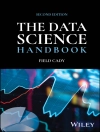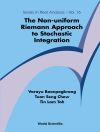This practical text is an essential source of information for those
wanting to know how to deal with the variability that exists in
every engineering situation. Using typical engineering data,
it presents the basic statistical methods that are relevant, in
simple numerical terms. In addition, statistical terminology is
translated into basic English.
In the past, a lack of communication between engineers and
statisticians, coupled with poor practical skills in quality
management and statistical engineering, was damaging to products
and to the economy. The disastrous consequence of setting tight
tolerances without regard to the statistical aspect of process data
is demonstrated.
This book offers a solution, bridging the gap between
statistical science and engineering technology to ensure that the
engineers of today are better equipped to serve the manufacturing
industry.
Inside, you will find coverage on:
* the nature of variability, describing the use of formulae to
pin down sources of variation;
* engineering design, research and development, demonstrating the
methods that help prevent costly mistakes in the early stages of a
new product;
* production, discussing the use of control charts, and;
* management and training, including directing and controlling
the quality function.
The Engineering section of the index identifies the role of
engineering technology in the service of industrial quality
management. The Statistics section identifies points in the text
where statistical terminology is used in an explanatory
context.
Engineers working on the design and manufacturing of new
products find this book invaluable as it develops a statistical
method by which they can anticipate and resolve quality problems
before launching into production. This book appeals to
students in all areas of engineering and also managers concerned
with the quality of manufactured products.
Academic engineers can use this text to teach their students
basic practical skills in quality management and statistical
engineering, without getting involved in the complex mathematical
theory of probability on which statistical science is
dependent.
Table of Content
About the Author vii
Foreword ix
Preface xi
Acknowledgements xiii
1 Nature of Variability 1
2 Basic Statistical Methods 9
2.1 Variance 9
2.2 Divisor ‘n’ or ‘n-1’? 11
2.3 Covariance and Correlation 13
2.4 Normal Distribution 14
2.5 Cumulative Frequency Distributions 18
2.6 Binomial Distribution 20
2.7 Poisson Distribution 25
2.8 Chi-squared Distribution 26
Bibliography 31
3 Production 33
3.1 Sampling Inspection 34
3.2 Control Charts 37
3.3 Cusum Charts 40
3.4 Significance Tests 43
3.5 Analysis of Variance 49
3.6 Linear Regression 52
Bibliography 57
4 Engineering Design 61
4.1 Variance Synthesis 61
4.2 Factors of Safety 68
4.3 Tolerances 69
4.4 The Future 71
Bibliography 72
5 Research and Development 75
5.1 Design of Experiments 76
5.2 Evolutionary Operation 95
5.3 Multiple Regression 96
5.4 More Statistical Methods 111
Bibliography 115
6 Background 119
6.1 Measurement 119
6.2 Statistical Computing 121
Bibliography 127
7 Quality Management 129
7.1 Quality Planning 129
7.2 Quality Organisation 135
7.3 Directing the Quality Function 137
7.4 Controlling the Quality Function 140
7.5 Statistical Engineering 141
Bibliography 142
8 Conclusion 145
Appendix A: Guidelines 147
Appendix B: Recommended Books 151
Appendix C: Periodicals 161
Appendix D: Supplementary Bibliography 165
Appendix E: Statistical Tables 171
Index 173
About the author
S.J. Morrison, retired, Department of Operational Research, University of Hull
Mr. Samuel Jim Morrision has been retired for 20 years now, his last post being as Head of the Department of Operational Research at the University of Hull. He contributed a great deal to the pioneering of statistics in industry and operational research, and set up the first postgraduate management course at Hull. He is a Fellow of the Institution of Mechanical Engineers, the Royal Statistical Institute and the Chartered Mangagement Institute. He is also a senior member of the American Society for Quality.
Jim has been a speaker at conferences and meetings (including the IMS meeting of 1999 ‘Statistics in the Education of Engineers’) where he has encouraged the use of simple statistics within the engineering industry. He has written many articals and papers on statistical engineering as the key to quality, writing often for the IET.












